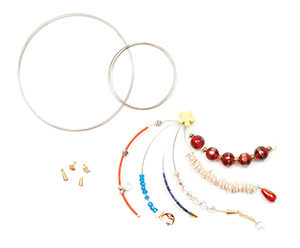Memory wire that remembers its shape? What a fun concept! There aren’t too many things in this life that can be stretched out, only to return to their original form once released. From stylish and sophisticated, to projects made by or for kids, this versatile beading wire can be used for more than just the obvious!
Made of tempered stainless steel, memory wire is sold in coil forms ranging from ring size to bracelet and necklace diameters. Tarnish and corrosion resistant, you’ll find it in shades of silver and gold with plated versions of the same metal tones also available.
One size fits all, unlike ordinary wire, and the unique ability to “remember” its curved nature gives it a “grip” factor. Stretch out a coil and you’ll feel it almost pulling the ends back together. Release too quickly and it just might flip out of your hands as it rapidly seeks to return to its circular form.
Don’t let its thin gauge (or wire thickness) fool you; this type of beading wire is made of hardened steel. It’s strong and can be difficult to cut, especially if you’re using the wrong type of pliers. Whatever you do, never use your best pair of jewelry wire cutters or nippers to cut memory wire. Doing so will leave your pliers with a damaged cutting surface, and if you do manage to cut the wire with these tools, they will create a very sharp edge.
If you work with memory wire, you’ll want to invest in a pair of memory wire shears. As the name implies, this tool shears (or breaks) the tempered steel wire rather than simply cutting it. The result is a flat and clean edge.
Wire lengths needed for a given beading project are sometimes listed in instructions as an exact measurement, referring to the length measured when the wire is stretched out. You’ll commonly find it listed by the number of continuous coils (or half coils) needed. Rings and bracelets can range from 1-5 continuous coils of beading wire, while necklaces typically call for 1-2, depending on the style.
Before sliding beads onto wire, finish one end to prevent beads from slipping off the opposite end as you work. You can make a simple loop by gripping a wire end with pliers and then bending it back towards the outer edge of its natural curve to form a loop. Slide on your chosen beads, charms and spacers, then leave a quarter inch of wire and repeat on the opposite end. Another option is to attach end caps. Square-, cone- or ballshaped caps can give ends a professional “polished” look. End caps are available with or without attached rings for adding beads or charms.
You can use a jump ring to attach charms, chain lengths or toggle clasps from either looped wire ends or end-cap rings. Another fun option is to string a coordinating bead (or beads) onto a head pin, and attach it to the end of your design. Samples of some of the possibilities are shown below.
Perhaps one of the biggest questions is how best to attach end caps to the wire. For a better bond, giving glue something to grip when attached to the smooth wire surface, ends should be lightly sanded using fine grit sandpaper to scuff. Cyanoacrylate glues such as Beadalon® Bead Fix™ or Super Glue® are the best choice to attach end caps. It is also possible to use a two-part epoxy, but this requires a longer (24 hour) set time, making it more difficult to use.
Slide one or more focal beads onto the beading wire or fill it completely with seed, E, or other beads and metal spacers to create fun beaded jewelry. Leave beads free to slide on memory wire, or separate to hold their position with lengths of hollow rubber tubing. This tubing is sold in black and sheer opaque varieties. It comes in sizes ranging from 1.7mm to 6mm and is easily cut with scissors. Cut it into short or long lengths and use to create spacing to add focus to beaded portions of the piece of beaded jewelry.
Don’t limit memory wire to jewelry only. Napkin rings, glass charms, ornaments and other home decor projects are also fun to explore. Try cutting shorter lengths of the wire and bending loops at ends, creating curved “eye pins” that hold their shape. Several individual coils of any given memory wire size can be connected using spacer bars to form a single ring or bracelet.
Once you begin to explore the endless uses for memory wire, you may just find that you can’t get enough of it! Fast, fun and easy to use, this beading wire is a great addition to any crafter’s repertoire.
By Lisa Galvin





